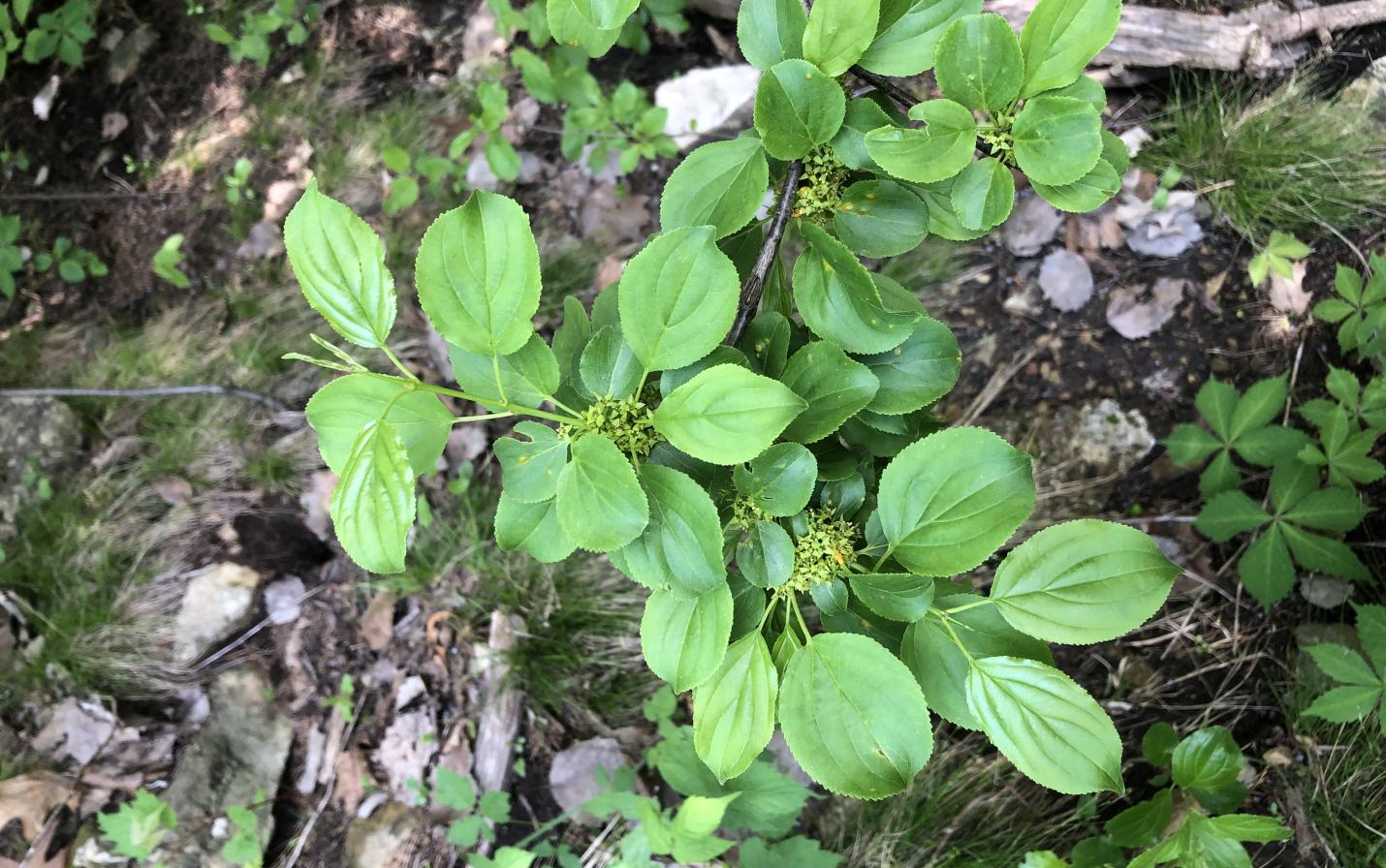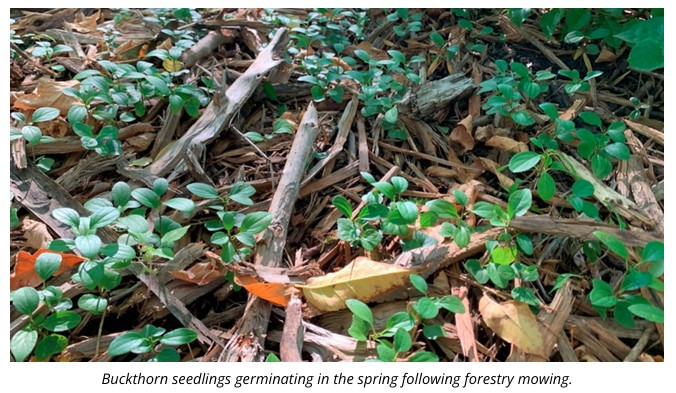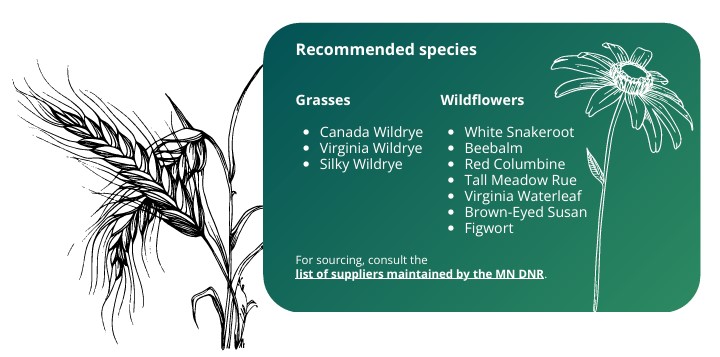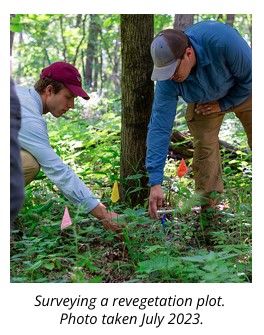
Revegetation (the re-establishment of plant cover through seeding or planting) is almost always advantageous and often necessary to achieve temperate forest restoration goals following removal of invasive plants, such as buckthorn (Rhamnus cathartica). For example, without revegetation, managed areas can quickly return to a buckthorn-dominated state, thus prolonging need for management and increasing associated economic and environmental costs. This article synthesizes current knowledge on forest understory revegetation and is designed to provide science-driven guidance on strategies that effectively suppress invasive plant re-establishment and promote native biodiversity. Herein we focus on buckthorn in particular, a widespread and resilient invader of forest understories through much of North America.
Initial management considerations
There are many different approaches that can be utilized in initial control efforts of a site already heavily occupied by buckthorn. No one approach is perfect: each has associated strengths and limitations, and a combination of different approaches is often necessary based on varied conditions within each site. Prominent buckthorn removal approaches are summarized by: University of Minnesota Extension & Minnesota Department of Natural Resources
Initial management of buckthorn should focus on reducing the total number of living stems within the treatment area. This includes prioritizing fruiting trees (note: trees that are not fruiting at the time of management may become fruiting in subsequent years) and ensuring adequate treatment of targeted stems. Stems that are damaged but not killed will resprout, replacing each damaged stem with many more new shoots. Although this article focuses on buckthorn invaded understories, many of the strategies outlined here are likely to support restoration efforts in other contexts as well. The same mechanisms that allow revegetation to effectively suppress buckthorn can be applied to suppress other invasive plant species, including honeysuckles and garlic mustard.

What about goats?
Scientific evidence on the efficacy of goats in buckthorn control is scarce and more research is needed to determine when and how goats can be best utilized in buckthorn control. However, available evidence suggests that targeted grazing by goats is not a universally effective approach to controlling buckthorn. Prior to management, most sites contain buckthorn that are either too large to be consumed by goats or are so small that they are easily missed, and stems that are targeted by goats often resprout, leading to thicker buckthorn regrowth. Goats can also damage remaining native plants and can contribute to soil disturbance and erosion. Consequently, grazing alone is not advisable as an approach to initial buckthorn control in wooded areas. Grazing may be effective when combined with other methods of control in some settings. Areas that contain mostly small buckthorn or those that have undergone mechanical removal and are now heavily dominated by resprouts may benefit from repeated grazing over multiple years. Deploying goats regularly over 3-6 years can reduce the abundance of these smaller stems. Restoring native biodiversity following grazing often requires active revegetation, but non-target impacts of grazing may not be compatible with native plant establishment.
Why revegetate?
Restoration of native plant communities is challenged by all buckthorn that remain following initial management: resprouting stems, stems (typically small) that escape initial management, and new stems establishing from seed. The growth and survival of remaining stems is significantly enhanced following the removal of their larger predecessors. Without other buckthorn to soak up light and other resources, remaining stems grow much larger and faster than they would otherwise, quickly reclaiming dominance of the site. Revegetation replaces the competition exerted by large buckthorn with that of native plants, allowing them to steal key resources back before remaining buckthorn grow too large.
When to revegetate
Any revegetation done with the goal of suppressing buckthorn should be conducted as soon as possible following initial management (removal of large stems). Often this means seeding in winter or planting in early spring. Mature buckthorn trees are prolific seed-producers that can leave behind a legacy of thousands of seeds that are “banked” in the soil. These seeds will germinate within two years and exert significant invasion pressure in the years following initial management. Buckthorn seedlings are most vulnerable to competition in their first year of life and become progressively more resistant as they age. By their third year, the probability of any one buckthorn stem dying drops significantly. Establishing dense vegetation to compete against seedlings when they are small and vulnerable will provide the best chance at suppression.
Benefits of revegetation
Primary benefits:
- Soak up resources liberated by management
- Reduce subsequent invasion of buckthorn and other exotic species
- Reduce need for additional management, including herbicides
- Improve efficacy of additional management
Secondary benefits:
- Increase biodiversity
- Improve habitat for wildlife/pollinators
- Increase value of natural areas to humans
- Reduce erosion, improve water quality
- Revegetating with grasses and wildflowers
Grasses and wildflowers are suitable for sites with more than 10% canopy openness (i.e. more than 10% of the sky is visible through the tree canopy above). Darker sites will not provide enough light to support the rigorous growth (particularly of grasses) needed for buckthorn suppression and alternative revegetation strategies (see below) are required. Similarly, areas with more than a few inches of ground covering debris (e.g. mulch from a forestry mower) can reduce the efficacy of seeding. When conditions are right, grasses and wildflowers can establish quickly from seed, allowing large areas to be densely revegetated at relatively low cost.
Seed mixtures designed to suppress buckthorn should focus primarily—if not exclusively—on cool-season (C3) grass species. Grasses generally establish quicker than wildflowers and leave a layer of thatch that reduces light to underlying buckthorn later into the autumn than is possible for most wildflowers. This layer of thatch can also enhance the efficacy of other management, especially the use of prescribed fire which is typically limited by low fuel levels.
Understory grasses are also fairly inexpensive and can tolerate several types of common herbicides (e.g. Triclopyr) better than wildflowers. These attributes make grasses the primary competitors against buckthorn invasion during the critical first few years after management when buckthorn are most vulnerable. Seeding grasses at rates of at least 60 seeds per square foot (about 8 lbs per acre) is recommended. Although there are many cool-season grass species that are readily available from seed suppliers, wildrye grasses (Elymus genus) warrant special consideration. Wildryes establish quickly after seeding, can establish densely in open woodlands, and are tall enough and have large enough leaves to shade underlying buckthorn. In particular, Canada, Virginia, and Silky wildrye have been used effectively to reduce buckthorn invasion across a wide range of buckthorn-invaded understories.
Wildflowers can take several years to establish, but are more shade-tolerant than grasses and can self-perpetuate for many years. Wildflowers also improve habitat for wildlife and provide floral resources for pollinators. So, although wildflowers don’t grow fast enough to suppress the initial wave of buckthorn, dense and diverse patches of wildflowers may be helpful in securing longer-term resistance to invasion and improving overall forest health. Because they are not contributing significantly to buckthorn suppression in the short-term, if included, wildflowers can be seeded at lower rates and can be more tailored to other management goals. Warm-season grasses establish more slowly than cool-season grasses, but are persistent if there is sufficient light and can play a role in maintaining long-term vegetation cover and diversity as well.
Recommended species:

For sourcing, consult the wildflowers list of suppliers maintained by the MN DNR.
Revegetating with woody species
Trees and shrubs have a wide range of growing requirements and can be selected to fit almost any site that has been invaded by buckthorn, including those too dark to support grasses. Trees and shrubs compete with buckthorn more strongly than either grasses or wildflowers due to similarities in growth requirements and physiology, but are more challenging to restore at high densities. Species that hold their leaves late into autumn are particularly effective competitors since buckthorn relies on autumn light for continued growth and survival: plants that reduce buckthorn light capture in this critical time have been shown to be highly effective at preventing buckthorn invasion. For this reason, species that hold their leaves late into autumn (red elderberry), evergreen species (balsam fir), and shade-adapted species (sugar maple) can be effective choices in understory revegetation.
Revegetation with woody species typically requires planting bare-root stems, plugs, or containerized plants. Due to the cost and logistical challenges associated with planting rather than seeding, woody revegetation yields fewer plants and much more localized impacts than revegetation with grasses and wildflowers. To suppress buckthorn, revegetated woody species should be planted at sufficient densities to produce continuous cover within two years after initial management (often only possible at small scales). Otherwise, managers should seek to establish the largest density of woody stems possible.

Native woody volunteers that recruit naturally (e.g. black cherry commonly co-occurs with buckthorn) can augment planting to increase total woody density. Lower densities will have proportionally lower impact and only affect buckthorn immediately surrounding planted stems. Inter-seeding with grasses can therefore enhance management outcomes by filling gaps between woody stems. Seeds of some woody species are available commercially and a wider range of species can be collected by hand (albeit with considerable time and effort). Seeding woody species may offer an alternative to planting, but the scarcity of seeds, as well as differences in plant size, structure, and growth requirements mean that there are currently no guidelines available for effective woody plant revegetation by seed. Establishing buckthorn-suppressing woody cover via seeding is the subject of ongoing research.
Aside from logistical challenges to establishing dense woody cover, revegetation of trees and shrubs requires a dedicated strategy to mitigate impacts of deer and other
herbivores. In the absence of fencing or caging, planted native woody stems are highly vulnerable to deer browsing and are preferentially browsed over buckthorn. Woody
revegetation in areas with frequent deer activity therefore can only be effective if paired with fencing or caging.
Follow up and monitoring
Revegetation can effectively suppress small buckthorn plants, and those newly germinating from seed. However, natural variation in revegetated plant cover will allow some buckthorn to persist and birds (e.g. American robin) often disperse viable seed from adjacent areas. More critically, revegetation alone is insufficient to fully control resprouting buckthorn stems since these stems draw on energy stored in their roots to quickly grow taller than revegetated plants. Therefore, managers must follow-up on revegetated sites and perform supplemental management (see initial management) to prevent re-sprouts and other escaped buckthorn from re-establishing dominance.
Techniques used for follow-up management will often depend on site conditions, the type of revegetation used, and the abundance of resprouting buckthorn.
- Mechanical removal is highly adaptable, particularly when conducted by hand since practitioners can be selective in which plants to remove and can be performed as needed based on buckthorn growth.
- Herbicides offer a more comprehensive approach, particularly in areas without revegetated forbs or woody species.
- Use of Triclopyr foliar spray can effectively treat large areas of remnant buckthorn stems and resprouts without affecting revegetated grasses.
- Foliar spray should occur at the end of the first growing season (after native plant dormancy but prior to first frost; September-October) following initial management and revegetation and can be repeated as needed over time.
- Spring prescribed burns can also be effective at removing small stems (not resprouts) in areas where grasses have built fine fuel loads. Because burns rely on dense grass cover, they should be conducted when grasses are most abundant (in the second or third year following initial management and revegetation).
Example timeline and seed mixes
For more information on management timelines and seed mixes used in our research, visit www.coveritup.umn.edu.
Acknowledgements
This research was supported by the Minnesota Invasive Terrestrial Plants and Pests Center, which receives funding from the Environment and Natural Resources Trust Fund as recommended by the Legislative-Citizen Commission on Minnesota Resources.
References
Ceccon E, González E, Martorell C (2015). Is direct seeding a biologically viable strategy for restoring forest ecosystems? Evidences from a meta-analysis. Land Degrad Dev 27:. https://doi.org/10.1002/ldr.2421
Delanoy L, Archibold OW (2007). Efficacy of control measures for European buckthorn Rhamnus cathartica L. in Saskatchewan. Environ Manage 40:709–718. https://doi.org/10.1007/s00267-006-0409-1
Knight KS, Kurylo JS, Endress AG, et al (2007). Ecology and ecosystem impacts of common buckthorn (Rhamnus cathartica): a review. Biol Invasions 9:925–937. https://doi.org/10.1007/s10530-007-9091-3
Mundahl ND, Walsh R (2022). Bark-stripping of common buckthorn by goats during managed browsing on bur oak savannas. Biol Invasions 24:481–493. https://doi.org/10.1007/s10530-021-02656-8
Nelson S (2022). An evaluation of goat browsing and other restoration strategies in buckthorn-invaded woodlands and savannas. https://hdl.handle.net/11299/252468
Schuster MJ, Wragg PD, Roth AM, et al (2022). Using plants to control buckthorn (Rhamnus cathartica): Improved biotic resistance of forests through revegetation. Ecol Eng 182:106730. https://doi.org/10.1016/j.ecoleng.2022.106730
Schuster MJ, Wragg PD, Roth AM, Reich PB (2023). No evidence of a long-lived seedbank in common buckthorn, Rhamnus cathartica L., within Minnesota deciduous forests. Biol Invasions 25:3043–3048.
https://doi.org/10.1007/s10530-023-03113-4
Schuster MJ, Wragg PD, Williams LJ, et al (2020). Phenology matters: Extended spring and autumn canopy cover increases biotic resistance of forests to invasion by common buckthorn (Rhamnus cathartica). For Ecol Manag 464:118067. https://doi.org/10.1016/j.foreco.2020.118067
Wragg PD, Schuster MJ, Roth AM, et al (2021). Revegetation to slow buckthorn reinvasion: strengths and limits of evaluating management techniques retrospectively. Restor Ecol 29:1–8. https://doi.org/10.1111/rec.13290